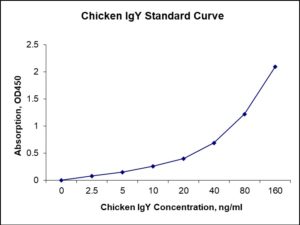Nori Chicken IgY ELISA Kit
$461.00 – $832.00
This ELISA kit is for quantification of IgY in chicken. This is a quick ELISA assay that reduces time to 50% compared to the conventional method, and the entire assay only takes 3 hours. This assay employs the quantitative sandwich enzyme immunoassay technique and uses biotin-streptavidin chemistry to improve the performance of the assays. An antibody specific for IgY has been pre-coated onto a microplate. Standards and samples are pipetted into the wells and any IgY present is bound by the immobilized antibody. After washing away any unbound substances, a detection antibody specific for IgY is added to the wells. Following wash to remove any unbound antibody reagent, a detection reagent is added. After intensive wash a substrate solution is added to the wells and color develops in proportion to the amount of IgY bound in the initial step. The color development is stopped, and the intensity of the color is measured.
Alternative names for IgY: immunoglobulin Y
Laboratory Research Use Only not for diagnostic and therapeutic purposes or any other purposes.
- Description
- How Elisa Works
- Product Citation (0)
- Reviews (0)
Description
Nori Chicken IgY ELISA Kit Summary
Alternative names for IgY: Immunoglobulin Y
| Assay Type | Solid Phase Sandwich ELISA |
| Format | 96-well Microplate or 96-Well Strip Microplate |
| Method of Detection | Colorimetric |
| Number of Targets Detected | 1 |
| Target Antigen Accession Number | na |
| Assay Length | 3 hours |
| Quantitative/Semiquantitative | Quantitative |
| Sample Type | Plasma, Serum, Cell Culture, Urine, Cell/Tissue Lysates, Synovial Fluid, BAL, |
| Recommended Sample Dilution (Plasma/Serum) | No dilution for sample <ULOQ; sufficient dilution for samples >ULOQ |
| Sensitivity | 500 pg/mL |
| Detection Range | 2.5-160 ng/mL |
| Specificity | Chicken IgY |
| Cross-Reactivity | < 0.5% cross-reactivity observed with available related molecules, < 50% cross-species reactivity observed with species tested. |
| Interference | No significant interference observed with available related molecules |
| Storage/Stability | 4 ºC for up to 6 months |
| Usage | For Laboratory Research Use Only. Not for diagnostic or therapeutic use. |
| Additional Notes | The kit allows for use in multiple experiments. |
Standard Curve
Kit Components
1. Pre-coated 96-well Microplate
2. Biotinylated Detection Antibody
3. Streptavidin-HRP Conjugate
4. Lyophilized Standards
5. TMB One-Step Substrate
6. Stop Solution
7. 20 x PBS
8. Assay Buffer
Other Materials Required but not Provided:
1. Microplate Reader capable of measuring absorption at 450 nm
2. Log-log graph paper or computer and software for ELISA data analysis
3. Precision pipettes (1-1000 µl)
4. Multi-channel pipettes (300 µl)
5. Distilled or deionized water
Protocol Outline
1. Prepare all reagents, samples and standards as instructed in the datasheet.
2. Add 100 µl of Standard or samples to each well and incubate 1 h at RT.
3. Add 100 µl of Working Detection Antibody to each well and incubate 1 h at RT.
4. Add 100 µl of Working Streptavidin-HRP to each well and incubate 20 min at RT.
5. Add 100 µl of Substrate to each well and incubate 5-30 min at RT.
6. Add 50 µl of Stop Solution to each well and read at 450 nm immediately.
Background:
Immunoglobulin Y (IgY) is a type of immunoglobulin which is the major antibody in bird, reptile, and lungfish blood. It is also found in high concentrations in chicken egg yolk. As with the other immunoglobulins, IgY is a class of proteins which are formed by the immune system in reaction to certain foreign substances, and specifically recognize them. Ducks produce a truncated form of IgY which is missing part of the Fc region. As a result, it cannot bind complement or be picked up by macrophages.[1] In chickens, immunoglobulin Y is the functional equivalent to Immunoglobulin G (IgG). Like IgG, it is composed of two light and two heavy chains. Structurally, these two types of immunoglobulin differ primarily in the heavy chains, which in IgY have a molecular mass of about 65,100 atomic mass units (amu), and are thus larger than in IgG. The light chains in IgY, with a molar mass of about 18,700 amu, are somewhat smaller than the light chains in IgG. The molar mass of IgY thus amounts to about 167,000 amu. The steric flexibility of the IgY molecule is less than that of IgG.
Functionally, IgY is partially comparable to Immunoglobulin E (IgE), as well as to IgG. However, in contrast to IgG, IgY does not bind to Protein A, to Protein G, or to cellular Fc receptors. Furthermore, IgY does not activate the complement system. The name Immunoglobulin Y was suggested in 1969 by G.A. Leslie and L.W. Clem, after they were able to show differences between the immunoglobulins found in chicken eggs, and immunoglobulin G. Other synonymous names are Chicken IgG, Egg Yolk IgG, and 7S-IgG.
Referemces
- Lundqvist, Mats L.; Darlene L. Middleton; Cynthia Radford; Gregory W. Warr; Katharine E. Magor (2006). “Immunoglobulins of the non-galliform birds: Antibody expression and repertoire in the duck”. Developmental & Comparative Immunology. 30 (1–2): 93–100.
Be the first to review “Nori Chicken IgY ELISA Kit”
You must be logged in to post a review.




























Reviews
There are no reviews yet.